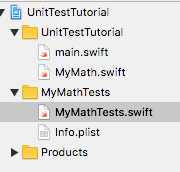ref – https://x-team.com/blog/how-to-get-started-with-ios-unit-tests-in-swift/
Create a Mac OS X project
File > New > Project
Under macOS, select Command Line Tool. Name it UnitTestTutorial.
Then create a MyMath class and enter some functions for adding and multiplying.
|
1 2 3 4 5 6 7 8 9 10 11 |
class MyMath: NSObject { static public func addition(num1: Int, num2: Int) -> Int { return num1 + num2 } static public func multiple(num1: Int, num2: Int) -> Int { return num1 * num2 } } |
File -> New -> File, and then under macOS, select Unit Test Case Class. If you are doing an iOS project, make sure you are under the iOS tab.
Name it MyMathTests.
You will then see a MyMathTests folder appear and see the MyMathTests.swift file.
Open the file and you’ll see something like this:
|
1 2 3 4 5 6 7 8 9 10 11 12 13 14 15 16 17 18 19 20 21 22 23 24 25 26 27 |
import XCTest class MyMathTests: XCTestCase { override func setUp() { super.setUp() // Put setup code here. This method is called before the invocation of each test method in the class. } override func tearDown() { // Put teardown code here. This method is called after the invocation of each test method in the class. super.tearDown() } func testExample() { // This is an example of a functional test case. // Use XCTAssert and related functions to verify your tests produce the correct results. } func testPerformanceExample() { // This is an example of a performance test case. self.measure { // Put the code you want to measure the time of here. } } } |
Writing test cases using XCTAssert
What we’ll do is to add code to testExample in order to run those tests.
Specifcically, XCTAssert is the starting name convention for a whole slew of test functions that you can use. Type in
XCTAssert, and a whole list of functions should appear at your disposal. You can test for truth, false, equals, Less Than, Nil, etc.
Basically, just follow the parameters and insert your functionality. There is usually a string parameter for you to put in case it fails.
|
1 2 3 4 5 6 7 8 9 10 11 12 13 14 15 |
func testExample() { // This is an example of a functional test case. // Use XCTAssert and related functions to verify your tests produce the correct results. XCTAssertTrue(MyMath.multiple(num1: 10, num2: 8) > MyMath.addition(num1: 10, num2: 8)) XCTAssertLessThan(MyMath.multiple(num1: 10, num2: 2), MyMath.addition(num1: 10, num2: 2), "Uh oh! Less Than testing failed ") XCTAssertEqual(MyMath.addition(num1: 2, num2: 2), MyMath.multiple(num1: 1, num2: 2), "UH OH! FAILED!") } |
output:
Test Suite ‘MyMathTests’ started at 2017-03-23 11:13:24.083
Test Case ‘-[MyMathTests.MyMathTests testExample]’ started.
/Users/rickytsao/Desktop/UnitTestTutorial/MyMathTests/MyMathTests.swift:29: error: -[MyMathTests.MyMathTests testExample] : XCTAssertLessThan failed: (“20”) is not less than (“12”) – Uh oh! Less Than testing failed
/Users/rickytsao/Desktop/UnitTestTutorial/MyMathTests/MyMathTests.swift:33: error: -[MyMathTests.MyMathTests testExample] : XCTAssertEqual failed: (“4”) is not equal to (“2”) – UH OH! FAILED!
Test Case ‘-[MyMathTests.MyMathTests testExample]’ failed (0.085 seconds).
Test Suite ‘MyMathTests’ failed at 2017-03-23 11:13:24.169.
Executed 1 test, with 2 failures (0 unexpected) in 0.085 (0.086) seconds
Test Suite ‘MyMathTests.xctest’ failed at 2017-03-23 11:13:24.169.
Executed 1 test, with 2 failures (0 unexpected) in 0.085 (0.087) seconds
Test Suite ‘Selected tests’ failed at 2017-03-23 11:13:24.170.
Executed 1 test, with 2 failures (0 unexpected) in 0.085 (0.088) seconds
Test session log:
/Users/rickytsao/Library/Developer/Xcode/DerivedData/UnitTestTutorial-aqmgqblqbwnvegfxiosuphlxvvyt/Logs/Test/54D591AF-874C-46FA-9840-4996047E7F05/Session-MyMathTests-2017-03-23_111319-FnoV9M.log
